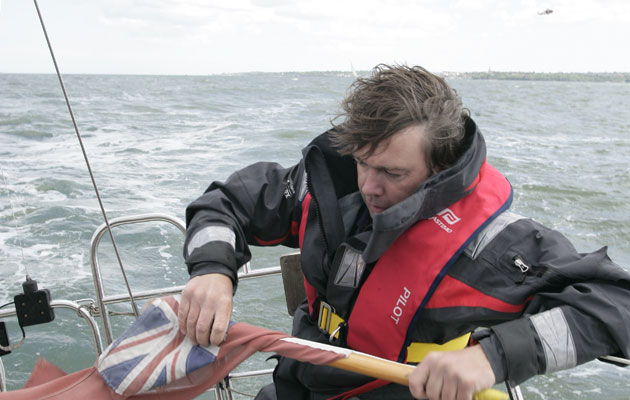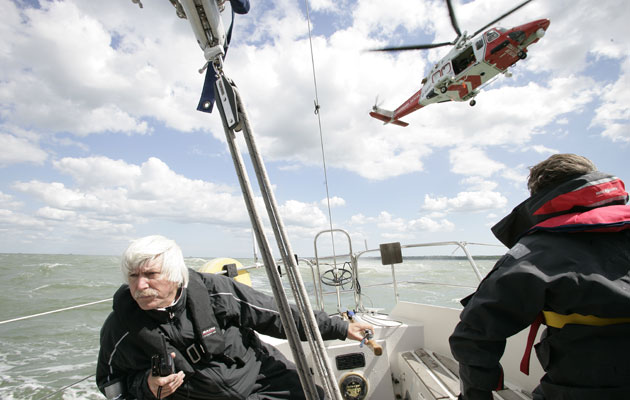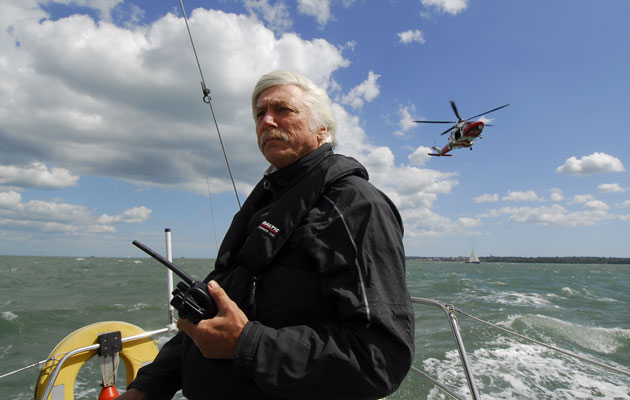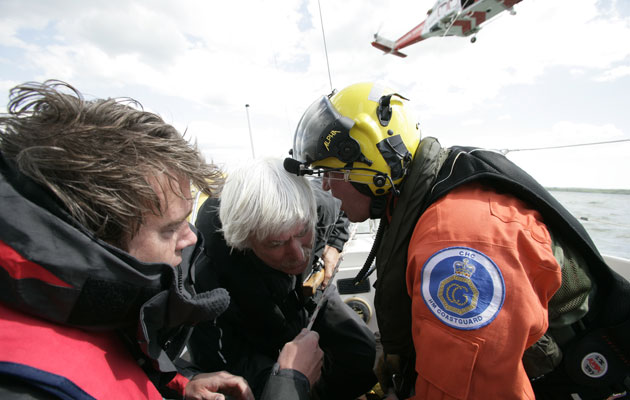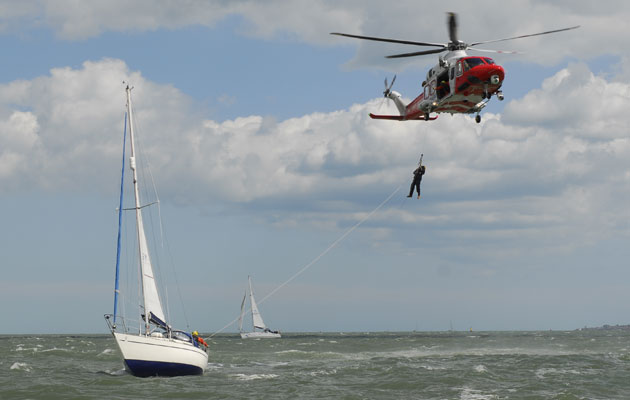A crewmember needs a helicopter rescue at sea, an airlift to hospital. You’ve radioed a Mayday and now there’s a helicopter overhead. What next? Tom Cunliffe reports
Helicopter rescue at sea
We often charter or borrow a yacht for Expert on board exercises, but on this occasion, Yachting Monthly photographer Graham Snook offered us Pixie, his Sadler 32, from Gosport. The date, chosen weeks in advance, brought a gale. It’s all very well photographing emergency procedures in flat calm. It’s another matter altogether in 35 knots of breeze, with wind against tide. For this reason, the exercise was without doubt the most useful and dramatic hi-line demo I’ve ever been involved with.
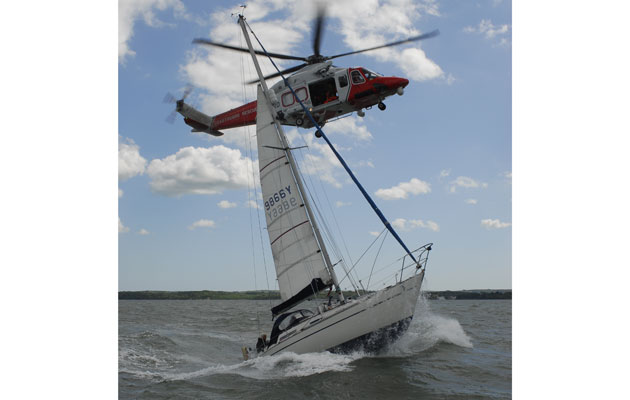
Tom Cunliffe has been involved in many hi-line rescue demonstrations, and this was one of the tougher ones
Pixie was almost literally standing on her ends as we scrabbled to grab the hi-line. While the winchman was trying to land on deck, crew Perry Cleveland-Peck had a serious job working the slack in the hi-line and heaving him in. Meanwhile, I was trying to concentrate on keeping the yacht in a straight line. On the VHF, I overheard the mention of our stern ‘going up and down three metres’. No wonder the poor SAR guy had a struggle, but he kept his cool, our crew managed to do what they’d been told, and he arrived without too many bruises. Alongside us was an inshore lifeboat carrying our second photographer, Lester McCarthy. Perry was duly hoisted skywards to be lowered into the lifeboat RIB, whence we retrieved him in the shelter of the Isle of Wight.
Rescue!
We all hope we’ll never need it, yet the possibility that one day we might tends to polarise sailors into two groups. One crowd shrink into a state of denial and expend no effort schooling themselves for the eventuality. The others can easily become ‘safety bores’, obsessive about how to shout for help and what to do when it arrives. They forget that good seamen concentrate on never having to bother the search and rescue (SAR) services without good cause.
My own natural inclination is to sign on with the first crew, but years of involvement with the training establishment has changed my thinking. If we sail for long enough, sooner or later we’ll all be caught out by a mistake – through shoddy gear, lack of maintenance, or by circumstances genuinely beyond our control. The healthy approach, as in so many things, is to take a middle view, doing all we can to avoid pressing the red button on our DSC radios, but knowing the system by rote in case the time finally comes.
A hundred years ago, a sailor in distress fired a flare and prayed. With luck, a pulling lifeboat would put out through the surf and local seamen in real risk of their lives would row out to save him. The contrast today is extreme. We make our distress signal electronically, perhaps backing it up with flares. If we’re anywhere near civilisation, we receive prompt attention. This may come via a lifeboat or, as is increasingly likely, a helicopter manned by highly trained professionals. Aircrew have a well-tried system for dealing with yachts but, for it to work as it should, those on board must do their share.
When it comes to educating ourselves, there’s no proper substitute for the real thing, but sitting under the hammering blades of a six-ton Agusta Westland AW139 in a gale of wind isn’t an experience open to everyone. RYA Yachtmaster Instructor courses often manage a session with the local SAR people, but not many private yachtsmen get the chance because, apart from difficulties of liaison, it costs a fortune to keep a helicopter in the air. For YM readers, however, it seems almost anything is possible. HM Coastguard at Lee-on-Solent managed to slot us into their schedule on the understanding that the exercise would be called off if their life-and-death services were needed for real.
A classic ‘hi-line transfer’
The theory
The most likely scenario is that the helicopter will lower a winchman straight down to your yacht to direct operations. Alternately, if it’s very calm, the helicopter crew may lower a lifting strop after a briefing about its use.
More helicopter rescues involve lifting a person from a yacht able to manoeuvre, than a yacht disabled in some way. The technique is called a hi-line transfer. Landing the helicopter crewman, plus a stretcher, or lifting strop, in the cockpit of a pitching yacht is far from easy. The hi-line makes it possible.
Preparation
A helicopter has limited flying time. The rescue needs to be smartly executed, so the crew awaiting the SAR people should do all they can to prepare.
Secure all loose gear on deck, or stow it below. Unsecured covers, ropes, even unstowed bits of clothing, are easily lifted by the down-draught of the rotors. They can cause chaos on deck. They can even be sucked into the helicopter’s air intakes and threaten engine failure.
The winchman will board you on the port quarter because the pilot sits to starboard in the aircraft and he needs to see you.

The winch operator, who monitors proceedings from a bubble hatch to starboard, can even control the helicopter in hover
The hatch is on that side too, so clear away everything movable from the critical area.
This includes danbuoys, aerials and even the ensign staff.
If your engine is powerful and reliable, or if there’s very little wind, drop the mainsail and headsail. Now lower the boom to the deck if you don’t have a fixed rod kicker. Lash it down to starboard and take the topping lift to the mast.
If you don’t trust your engine or are in any doubt about it, get ready to sail closehauled on the port tack.
Put your best helmsman or woman on the job. Once things start happening, their task will be to steer absolutely straight in the direction the helicopter crew ask for. The helm must not be distracted, whatever happens.
What to do when the helicopter arrives
If the area is crowded with other craft, you may well spot the helicopter before its crew identify you. Do anything you can to say: ‘It’s us!’ An orange smoke flare is best by day. If you don’t have one, wave the ensign or a hi-vis life jacket. Try VHF radio (Ch 67), then imagine yourself in the pilot’s seat and advise along these lines: ‘I am ahead of you and to your port side,’ for example. At night or in bad visibility, use a red pinpoint flare, but never use a parachute flare.
Helicopters are unbelievably noisy, and communicating by radio during the action can be a challenge, so don’t feel embarrassed to ask the rescue crew to ‘say again’ any message.
If there’s been a breakdown in communication, the helicopter may well fly past showing a large sign with something like ‘VHF 67’ on it. Comply if you can. If your radio is down, make suitable gestures and be ready to receive a hi-line or a lifting strop.
Stand by to receive instructions. You won’t want to be down below, or doing the old ‘jack-in-the-box’ act up and down the hatch, so if you have a hand-held radio, use it. If you’re short-handed, give it to the helm and let him/her relay instructions. The best line handler, or the strongest person in your crew, should be the one chosen to deal with the hi-line.
The pilot will brief you. Listen carefully and don’t be afraid to ask for a repeat.
You’ll probably be asked to motor as fast as you comfortably can upwind. If communication fails and it’s breezy, steer straight to weather or close-hauled on the port tack, making your best speed. At night, the helicopter may survey you for some time with searchlights to locate obstructions. Be ready to turn any deck lights on or off as requested.
Once briefed, get going. This is where you and the SAR guys will be glad you chose the best person to steer. It’s so tempting to look up, but don’t let it happen. Given half a chance, a modern yacht jumps off course like a bluebottle in a hot kitchen, which makes the helicopter pilot’s job impossible.
Don’t be alarmed by the shocking racket of a helicopter overhead at low altitude, and don’t worry about the downdraught. Unless there’s no wind, the aircraft stays out on your quarter during the transfer and it’s not a problem.
The big lift
The helicopter winch can easily lift two or more people.
If quick evacuation of more than one casualty is required, two strops may be lowered under the supervision of the helicopter’s winchman.
If it’s very calm or your yacht is very big, the helicopter may lower a lifting strop directly to you after a briefing about its use. Alternatively, and more likely, they will send a winchman straight down to direct operations. In most other circumstances, the crew will opt for this ‘hi-line transfer’ method.
The hi-line is a light line with a weight on its lower end, attached by a weak link to the helicopter’s winch cable. Its purpose is to allow the yacht’s crew to guide the main winch wire while the winchman, a stretcher, or a lifting strop is lowered and lifted away again.
Here’s how it happens:
The helicopter hovers more or less overhead and lowers the hi-line to you.
Your job is to grab this and take in the slack. Gloves are a good idea.
Flake it onto the deck or cockpit sole. Some people use a big bucket, but whatever you do, don’t secure it. If it gets snagged, and a ‘tug of war’ results, the weak link snaps and they’ll send you down another.
The helicopter moves away over your quarter while the pilot gets his bearings. Keep taking up or giving slack so that the hi-line is clear for action and has no chance whatever of finding your propeller.
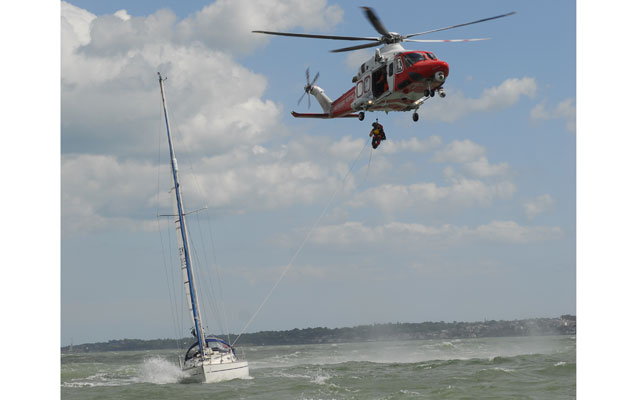
As the winchman descends, take up the slack in the hi-line. You may need to pull the winchman towards the yacht
Next, a winchman or a rescue device is lowered on the main winch cable. Take up the slack on the hi-line as it comes, then use it to heave him or the device to safety on board. This might need a hefty pull, so don’t give the job to little Johnnie.
Whatever is coming down, an earthing wire will be lowered into the water from the main wire before you grab it. You will not get a static electric shock from the hi-line.
If a winchman is lowered, he’s in charge, so follow his instructions. These will be hard to hear because of the noise from above. Don’t be shy of putting your ear right next to him. If only a strop comes down, secure evacuees as appropriate and signal to lift with ‘thumbs up’.
A lifting strop features a toggle to tighten it under the arms for security. If it’s you on the wire, keep your arms by your sides.
The yacht crew now ease out on the hi-line, keeping enough tension to stop the lift swinging wildly. Don’t release it altogether if it might be required again.
When no further lifts are needed and when you are instructed to do so, let go the end of the hi-line, keeping an eye on the weight so it doesn’t swing and injure someone.
The helicopter winch can easily lift two or more people. If quick evacuation of more than one casualty is in order, two strops may come down.
When conditions are so dire that even hi-lining is dangerous, the helicopter pilot may direct you to stream a casualty astern in a dinghy or even in a liferaft on a long painter. In the most extreme circumstances, such as abandoning ship, you might be instructed to get into the water. If so, make sure all crew are wearing lifejackets and don’t jump until directed. You don’t want to be in the water for any longer than necessary. Note also that helicopters carry special double strops for raising vulnerable people, such as hypothermia victims, who are at risk from the ‘post-rescue collapse’ caused by lifting in a vertical attitude.






